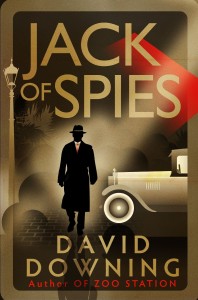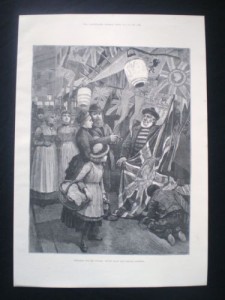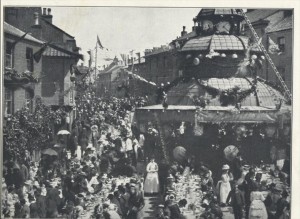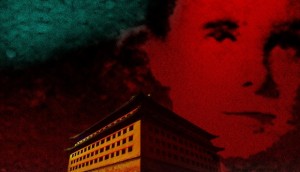Posted: November 30th, 2013 | No Comments »
Andrew Lycett’s new biography of Wilkie Collins, A Life of Sensation is now out. Wilkie Collins and China? Any connections? Appears there is a small one (so perfect for this blog). Collins’s No Name was published in 1862 after he had found success with The Woman in White. It handles the subject of illegitimacy, a serious subject in the mid-nineteenth century of course. The reviewers didn’t like it (a bit scandalous for the times), the public loved it. The plot concerns a young girl, Magdalen Vanstone, who becomes engaged to a rather feckless young man, Francis Clare. Clare is sent off to China to make his fortune.

No Name is actually quite instructive of attitudes to working in China in the 1840s (the book is set 15 or 20 years prior to its publication). Clare works for a firm of traders in the City of London and is to be sent to their “correspondents” in China to familiarize himself with both the tea and silk trades for five years. He is based in Shanghai and arrives in 1846/47. He will return, it is expected, to a position of some rank thanks to his China knowledge and experience. The job is seen as a “banishment” by some of his family but as a means of making good money and eventually establishing his own trading company at some future point by others. It is suggested that while in China opportunities will afford themselves for him to make his fortune. As he is engaged the marriage will have to wait though it is suggested that in one year in the East he will make enough to pay for the dowry and be able to afford to marry.
Also interesting is the role of China in the book in terms of objects. Others who have been to China have returned with objects – Collins describes one house as containing, “Stuffed birds from Africa, porcelain monsters from China, silver ornaments and utensils from India and Peru, mosaic work from Italy and bronzes from France…” Another character heading to China promises to bring back a China shawl and a chest of tea.
Collins’s No Name is not essentially a book about China – China exists as a place far away to which a man may, or may not, go to make, or not make, a fortune but it is a neat literary example of how China was often central to many British families experiences in the mid-nineteenth century and an essential part of Britain’s international trade.

Posted: November 30th, 2013 | No Comments »
Philip Jowett’s The Armies of Warlord China should be worth a read – great cover too….
 China in the 1910s and 1920s was dominated by a succession of military strongmen who fought with each other for the control of the country. Weak central government meant that provincial governors or Warlords and their personal armies were left to fight over the country. The wars that resulted cost millions of civilian deaths and the death of hundreds of thousands of ordinary soldiers. In total a staggering 500 wars were fought over a seventeen year period from 1911 to 1928 starting with the fall of the Qing Dynasty and ending with the victory of the Nationalists in 1928. Some of these conflicts involved a few hundred men on each side, while the larger wars involved up to one million men with tanks, armored trains, and aircraft. This book will, for the first time, show in detail the history of the Armies of Warlord China featuring over 600 rare photographs and illustrations. The book also includes color sections on the uniforms, aircraft and awards and medals of the Chinese Warlord Armies.
China in the 1910s and 1920s was dominated by a succession of military strongmen who fought with each other for the control of the country. Weak central government meant that provincial governors or Warlords and their personal armies were left to fight over the country. The wars that resulted cost millions of civilian deaths and the death of hundreds of thousands of ordinary soldiers. In total a staggering 500 wars were fought over a seventeen year period from 1911 to 1928 starting with the fall of the Qing Dynasty and ending with the victory of the Nationalists in 1928. Some of these conflicts involved a few hundred men on each side, while the larger wars involved up to one million men with tanks, armored trains, and aircraft. This book will, for the first time, show in detail the history of the Armies of Warlord China featuring over 600 rare photographs and illustrations. The book also includes color sections on the uniforms, aircraft and awards and medals of the Chinese Warlord Armies.
Posted: November 29th, 2013 | No Comments »
Tired of the same old bars and all these would-be “speakeasies” (what’s that all about!) in Frenchtown? Of course you are – but sadly you can no longer visit the Kavkaz on Rue Lafayette (Fuxing Middle Road) but you could in the 1930s – wonder if Raisky’s Singing Strummers were any good? There was a notorious White Russian bar called the Kavkaz in the Peking Badlands too but I don’t think the two were linked in anything but name.

Posted: November 29th, 2013 | No Comments »
Peter Kitson’s Forging Romantic China looks like an interesting read on pre-Opium Wars Anglo-Chinese relations and interactions…

The first major cultural study to focus exclusively on this decisive period in modern British-Chinese relations. Based on extensive archival investigations, Peter J. Kitson shows how British knowledge of China was constructed from the writings and translations of a diverse range of missionaries, diplomats, travellers, traders, and literary men and women during the Romantic period. The new perceptions of China that it gave rise to were mediated via a dynamic print culture to a diverse range of poets, novelists, essayists, dramatists and reviewers, including Jane Austen, Thomas Percy, William Jones, S. T. Coleridge, George Colman, Robert Southey, Charles Lamb, William and Dorothy Wordsworth and others, informing new British understandings and imaginings of China on the eve of the Opium War of 1839–42. Kitson aims to restore China to its true global presence in our understandings of the culture and literature of Britain in the late eighteenth and early nineteenth centuries.
Posted: November 27th, 2013 | No Comments »
Just a quick follow up from my post about David Downing’s new book Jack of Spies which starts out in Tsingtau (Qingdao) and Shanghai. At one point while the book’s amateur spy hero Jack McColl is in Shanghai he notes the success the previous summer (the summer of 1913) of the new tales of Dr Fu Manchu written by Sax Rohmer. Of course it was indeed 1913 when Sax Rohmer published the first Fu Manchu book, a collection of short stories The Mystery of Dr Fu Manchu (or The Insidious Dr Fu Manchu, if you happened to be in America in 1913 where it went under that title) that had been published the year before separately in newspapers. Just in case you missed it that means that 2013 is the centenary of Fu Manchu. Downing’s character McColl would have had to read the first English edition to comment on the new series so early – and here’s the book he must have read….
 The Methuen first edition hard cover from 1913
The Methuen first edition hard cover from 1913
Posted: November 26th, 2013 | No Comments »
David Downing is following his very good, and very successful, “Station” series of Berlin WW2 novels with a new series set just before WW1 featuring British spy and luxury car salesman Jack McColl. It seems it will be a kind of “Lanny Budd” type series following the old Upton Sinclair formula of inserting a character as a witness to real events.
And where should we first encounter McColl in the first book of the series – Jack of Spies? Why, old Shanghai fans you’ll be delighted to know we encounter him on the Bubbling Well Road in 1913. Well, not quite. First McColl appears in Tsingtau (Qingdao) in late 1913 doing a bit of spying on the German fleet and old Vice Admiral Maximilian von Spee (later to go straight to the bottom of the South Atlantic in the Battle of the Falklands) and his German East Asian Squadron. Then he’s of to Shanghai and hops all over the Settlement and also enjoys an opium pipe in Frenchtown, as you do. A lot of fun and some nods to real events – Sidney ‘Ace of Spies’ Reilly was really in Port Arthur earlier and it was true that Special Branch were perpetually worried about the Indian community in Shanghai attempting to foster rebellion against the Raj in India from China. W could quibble with a few small things – qipao’s split to the hip in 1913 are a tad unlikely, but still it’s all good page turning fun. After Shanghai, McColl heads of to San Francisco but here’s hoping he one day makes it back to the Bubbling Well Road. He might well do later – in San Francisco our hero bumps into a young Agnes Smedley in a Mexican restaurant back in the days when contraception and Indian independence were her thing before she set of for China.

Posted: November 25th, 2013 | No Comments »
Today an engraving from the The Illustrated London News in June 1887 entitled Preparing for the Jubilee: Buying Flags and Chinese Lanterns. 1887 was Queen Victoria’s Golden Jubilee (50 years on the throne). “Jubilee Mania” broke out as people celebrated and, it would seem, Chinese lanterns were integral to the mania…

The UK seriously celebrated with London decked out in flags, and it appears Chinese lanterns, as over 50 heads of state piled into town for the celebrations, Irish Republicans planned to blow up Westminster Abbey. London was not the only place with Chinese lanterns – Ashburton in Devon opted for them too, according to the Ashburton Guardian, reporting that, “At night, most of the shops were illuminated, and in many parts of the town Chinese lanterns were a noticeable feature.” Similarly so at Pakenham, a village in Suffolk,where “the village street was prettily decorated with Chinese lanterns.” It obviously caught on quick – Treaton, a village in South Yorkshire, also decorated their high street, Front Street, with Chinese lanterns. At Beaumont School in Hertfordshire, “The outlines of the pediments had been traced in gas jets, the windows brilliantly lit up, and the front lodge and grounds decorated with Chinese lanterns.”
Indeed Chinese lanterns formed a major part of many processions too. For instance, in (the wonderfully named) Boggart Hole Clough, a park in Blackley in Manchester, “The North Central Manchester Division of the Boy Scouts marched in procession to the beacon in the park, each carrying a Chinese lantern.” The Manchester Guardian described the sight of all the little scouts with lanterns on their heads as “charming.” And so the list of villages up and down the UK that chose Chinese lanterns for their jubilee celebrations continues….Stansted Abbots in Hertfordshire, Eynsham near Oxford, Ryde on the Isle of Wight, Folkestone in Kent, Rolleston on Dove in Staffordshire, Leamington Spa in Warwickshire all used them on their high streets as did Carnarvon in Wales with the streets lit, “by a number of lighted candles, intermixed with pretty Chinese lanterns of varied colours.” The Market Place at North Walsham in Norfolk apparently outdid themselves with both Chinese and Japanese lanterns. Even Buffalo Bill, in town for the Jubilee with his Wild West Show as part of an American Exhibition, couldn’t resist a lantern – The Times noted, “At nightfall the grounds were illuminated in every part with innumerable coloured lamps and Chinese lanterns.”
 The Marketplace, North Walsham, Norfolk on the Jubilee, 1887
The Marketplace, North Walsham, Norfolk on the Jubilee, 1887
And it seems it wasn’t just England that chose Chinese lanterns as a key part of the decor for the celebrations – in Melbourne an “Oriental” celebration of the Jubilee reportedly had Chinese lanterns, according to the Melbourne Argus, as did Slacks Creek, near Logan in Queensland, while elsewhere in the Empire similar scenes occurred – Victoria Market in Kingston, Jamaica featured, “lanterns placed upon Chinese umbrellas, in the manner of a chandelier.” Many other cities in the Empire did the same including Ottawa.
America joined in too – “The General Committee in charge of the Jubilee of Queen Victoria” reported in the Daily Alta California newspaper that, “they had secured Woodward’s Gardens for June 22d, for the entire day” and that, “In the evening the Gardens are to be illuminated by hundreds of colored lanterns, electric lights and Chinese lanterns.”
And Queen Victoria herself, the subject of the celebrations, didn’t miss the lanterns writing in her diaries of the Chinese lanterns she saw people holding as she arrived at Windsor Castle.
Posted: November 25th, 2013 | No Comments »
This week sees the publication in Hong Kong of the new smaller format edition of Midnight in Peking and a new batch of hard copies of my small follow up book The Badlands – just ready for Christmas!!
The Badlands is a collection of shorter stories about some of the real foreigners who lived, worked, stole, dealt, whored, danced and died in the Badlands of Peking in the 1930s. But I kept one story back. Now the South China Morning Post’s magazine has run that one last story from the Badlands – the story of the mysterious Pinfold, a man who came to escape in Peking and became a gun for hire in the Badlands.
Click here to read Broken in the Badlands – Gun for Hire










